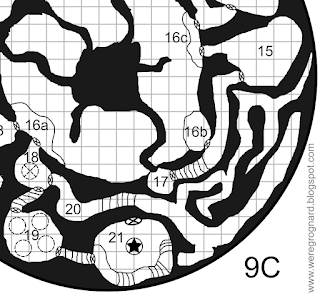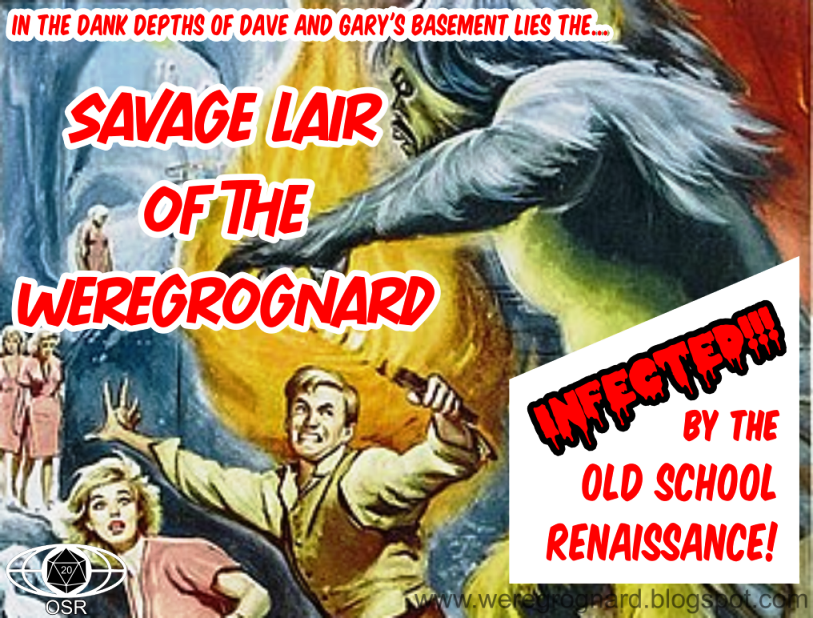Area C: Albumic Chambers – West
 |
This map is released under terms of the CC BY-SA 4.0 license. |
Room 15: Chamber of the Worm-Dragon
This chamber features the bones of a dragon resting on the floor. Worms like those that make up the handmaids are wriggling around them. On a negative reaction (assuming the PCs have an aboleth eye,) the worms swarm around the bones, and form an outer skin that animates the draconic remains. The worms around the dragons’ heads converge into a central, glowing eye like that of a handmaid.
Worm-dragon: AC 0 [19]; HD 9; MV 90 ft. (30 ft.); ATK 1d4+3/1d4+3/3d10 (two claws and one bite) or special; SV fighter 9; ML 10; AL C; XP 6,900 (or HD + two specials)
Eye of Absorption: the eye of a worm-dragon acts similarly to a rod of absorption. Spells cast at the worm-dragon are absorbed by the eye, storing the energy for later use. It can absorb up to 50 points worth of spell levels. The worm-dragon can then use that stored energy to cast one of the following spells, at the cost of one point per spell level: charm person, levitate, magic missile, mirror image, protection from evil, sleep, see (detect) invisibility, silent image (phantasmal force.)
Spell Breath: In addition to spells, the worm-dragon can discharge any stored spell energy as a breath attack. The breath is a five-foot wide, 100-foot long beam of psychic energy that deals 1d6 damage for every point of spell energy spent (up to 10 maximum.)
 |
| The worm-dragon forming (AI image courtesy of Bing Image Creator.) |
Room 16: Observation Decks
These balcony-like protrusions in the Ovoid's hollow core allow for a full view of a colossal, petrified creature suspended from massive, umbilical connections. The monumental, alien god cannot be affected by any means available to the player characters (PCs,) with the notable exception of a reversed, flesh to stone spell, which merely reveals a patch of pulsating, otherworldly flesh that is quickly restored to a petrified status by the Ovoid. In such a case, the Ovoid's alert level quickly rises to Active (2.)
 |
| The Petrified God in the Ovoid (AI image courtesy of Bing Image Creator.) |
Room 17: Umbilicus of Consumption
One of the umbilical tendrils that connects the petrified creature at the Ovoid’s core ends in this chamber as a pulsating, semi-spherical bulb. There are scattered, mundane items around it, including coins. A living or organic creature that gets close to the bulb (perhaps by rummaging through the items) triggers a feeding response from the umbilicus. The victim must save against spells or be instantly slain and their corporeal body consumed utterly. The victim is forever lost and cannot be raised without first employing powerful, reality-altering magic, such as a wish or divine intervention. Even on a successful save, the victim suffers 10d6 damage as their flesh becomes grayish, brittle and flaky from a disintegration effect.
The umbilicus can be temporarily deactivated (2d6 rounds) via a charm monster or dispel magic spell. Controlling the area's brain-node can also deactivate the umbilicus at will.
The piles of coins among the mundane items amount to 1,000 gp and 60,000 sp.
Room 18: Sphincter Pit the Third - Defensive Gizzard
This chamber contains a third, sphincter-hatch pit on the floor similar to Rooms 3 and 6. However, this one has been closed off at 70 feet to form a sac lined with sharp, calcareous protrusions. Falling characters suffer 7d6 damage and are pierced or scratched by one or more of the protrusion for 3d6-1 damage. The protrusions secrete a toxin that dissolves tissue from the inside. Characters must save against poison or die painfully in 1d6 rounds.)
Room 19: Bone Marionettes
This chamber features a vaulted ceiling with four (4) bone creatures (golems) like the one in Room 1, suspended from the ceiling by organic tendrils. The creatures appear to be dormant or inactive. Below each creature is a recessed pit over seven (7) feet deep with glittering coins below. Entering a pit activates and releases the bone creature above, which drops inside the occupied pit, and attacks anyone in it.
Each pit has 1d4+1 x 1000 sp and 4d6 x 100 gp.
 |
| Death from above (AI image courtesy of Bing Image Creator.) |
Room 20: Auxiliary Tunnels
This area is a labyrinth of multiple, tapering tunnels that lead nowhere. The Ovoid can transform these into chambers when necessary, but are currently unused. Areas 3-5 feet thick on the walls are weak and can be detected by searching for secret doors. However, destroying the walls alerts the Ovoid as normal.
Room 21: Sanctum of the Amber Brain Beast
This chamber is an organic rotunda with an amber statue carved into a vaguely animal form at the center. Inside the statue is a brain-node like other ones within the Ovoid. There are also 1d4 handmaids here: half tending to the encased brain-node, with the rest blend into the walls, dormant until danger is detected.
 |
| The guardian of this area's brain node (adapted from AI images courtesy of NightCafe and Bing Image Creator.) |
The handmaids here are wary of even those bearing an aboleth’s eyes (-2 to reactions.) In the event of combat, PCs must contend not only with the handmaids, but also the amber creature, which animates as a golem of the same material (HP 45.)
Valuable shards of amber can be recovered from the creatures remains. The lot is worth 3,600 gp to the right buyer and weighs twice that amount in coin.
The brain-node inside of the amber beast controls this area (Rooms 15-21,) which includes the larger sphincter-hatch on the wall that leads to the Ovoid's Embryonic Core (Area D.)
This work includes material taken from the System Reference Document 5.1 (“SRD 5.1”) by Wizards of the Coast LLC and available at https://dnd.wizards.com/resources/systems-reference-document. The SRD 5.1 is licensed under the Creative Commons Attribution 4.0 International License available at https://creativecommons.org/licenses/by/4.0/legalcode.




No comments:
Post a Comment